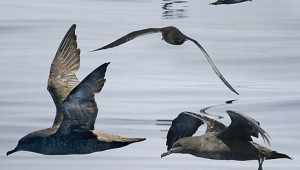Share on Social Media:
The Top 5 Longest Bird Migrations on Earth
| Bird | Migration | Estimated Distance | Red List Status | |
|---|---|---|---|---|
| 1 | Sooty Shearwater (Puffinus griseus) |
New Zealand, North America, South America, Antarctica, Africa | 64,000 km (40,000 miles) |
Near Threatened |
| 2 | Arctic Tern (Sterna paradisaea) |
North America (Arctic), Europe, Africa, South America,Antarctica | 33,000 km (22,000 miles) |
Least Concern |
| 3 | Pectoral Sandpiper (Calidris melanotos) |
Asia (Siberia), North America, South America, Australia | 28,000 km (18,000 miles) |
Least Concern |
| 4 | Pied Wheatear (Oenanthe pleschanka) |
Europe, Africa, Asia | 18,000 km (11,184 miles) |
Least Concern |
| 5 | Short-tailed Shearwater (Puffinus tenuirostris) |
North America, Asia, Australia | 17,000 km (27,000 miles) |
Least Concern |
 Special Report
Special Report
- The Arctic Tern held the record for longest migration distance flying about 30,000 km (18,600 miles) each year travelling between its arctic breeding ground and non-breeding area in the Antarctic however the Sooty Shearwater is now the undisputed holder of the record of having the longest migration of any animal on Earth after being tracked using electronic tracking technology. Arctic terns are too small to outfit with current electronic tags, so the true distance they cover remains relatively unknown. (a.)
- Some birds, specifically geese and ducks, fly at extreme heights. Bar-headed geese have been recorded as high as 29,000 feet (8,839 metres) when they migrate over the Himalayas which is about five miles up (8 kilometres) and higher than Mount Everest. (b.)
- Birds use the sun as a compass using the positions of the sun during the day to navigate. They also can use the setting sun as an indication of due west. To prepare for migration, birds become hyperphagic which means they eat a lot more food than normal, which is then stored as fat for their long journey. Fat is normally 3% to 5% of the bird's mass. Some migrants almost double their body weights by storing fat before migration.(b.)
- Night flyers use celestial navigation, which means they find their way by knowing the patterns of the stars in the sky, and by knowing special stars like the North Star. In their first year of life, birds memorize the position of the constellations in relation to the North Star. These star patterns stay the same even though the Earth moves through space, making the constellations appear to move to different spots in the sky during the year. (b.)
- Birds have tiny grains of a mineral called magnetite just above their nostrils. This mineral may help them to navigate using the Earth's magnetic field, which tells the bird what direction is true north. (b.)
- Roach, J. (2006). "Longest Animal Migration Measured, Bird Flies 40,000 Miles a Year". Retrieved January 3, 2011, from: http://news.nationalgeographic.com/news/2006/08/060808-bird-migration.html
- Scanlan, K., Piaskowski, V., Jacobi, M., Mahler, S. (2011). "Bird Migration Facts" Retrieved January 3, 2011, from: http://www.zoosociety.org/Conservation/BWB-ASF/Library/BirdMigrationFacts.php
Tags:
Animals & Nature, Top 5 Longest
Sources: Bird life International, National Geographic, IUCN Red list of threatened species.
List Notes: Distances are estimated except for the Sooty Shearwater which was tracked by electronic means.
Image By Richard Crossley (Richard Crossley) [CC-BY-SA-3.0], via Wikimedia Commons
Sources: Bird life International, National Geographic, IUCN Red list of threatened species.
List Notes: Distances are estimated except for the Sooty Shearwater which was tracked by electronic means.
Image By Richard Crossley (Richard Crossley) [CC-BY-SA-3.0], via Wikimedia Commons

